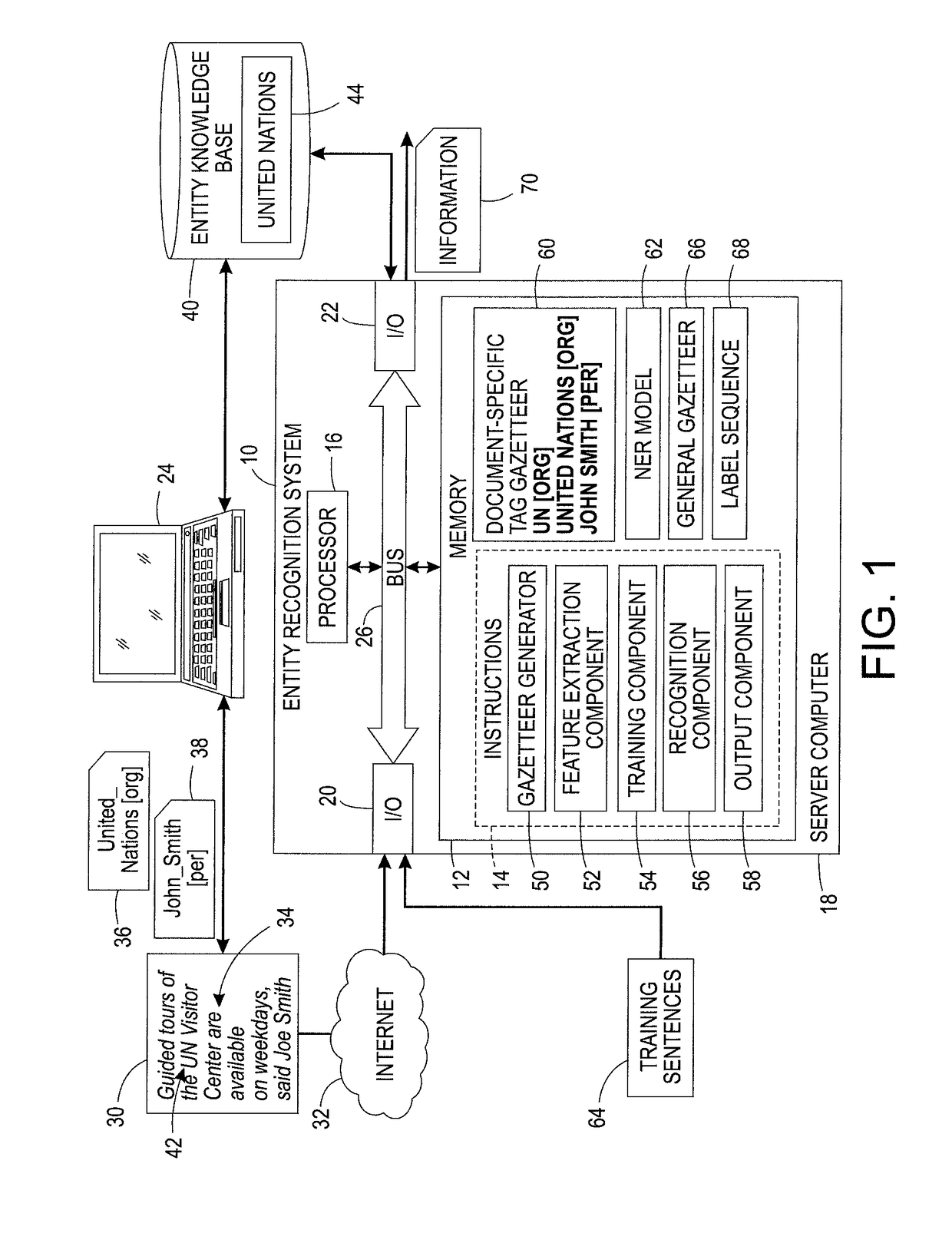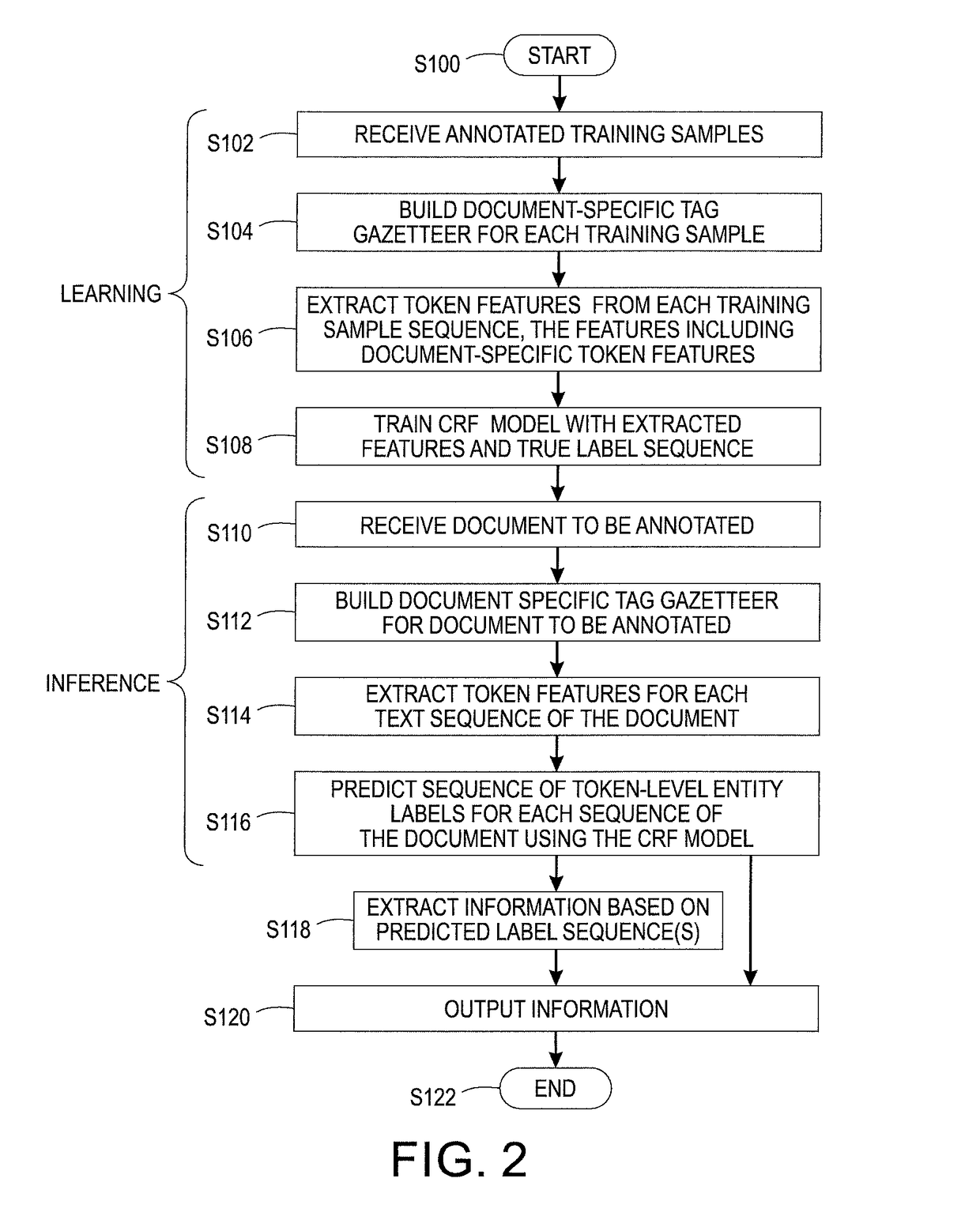Document-specific gazetteers for named entity recognition
a named entity and document technology, applied in document management systems, relational databases, instruments, etc., can solve the problems of reducing the performance of names once the data varies in language and domain, and consuming manpower and money to provide labels for every occurrence of names
- Summary
- Abstract
- Description
- Claims
- Application Information
AI Technical Summary
Problems solved by technology
Method used
Image
Examples
example 1
[0108]Table 1 shows the performance of the different system configurations on the TESTA development split of the CoNLL03 dataset. In this example, the models have access to entities drawn from all mentions in the document.
[0109]
TABLE 1Results for CoNLL03 TESTAMethodPrecisionRecallF-scoreCRF88.5286.8687.68CRF + WIDE90.4589.2689.85CRF + NAME + TYPE93.2992.1292.70CRF + NAME + TYPE + REL93.1792.1292.65
[0110]The baseline performs well at 87.68% F-score, and using large gazetteers improves to 89.85% F-score. The CRF+NAME+TYPE model achieves better performance than either CRF BASELINE or CRF+WIDE at 92.7% F-score. When the document gazetteers are augmented with related untyped spans from the KB (CRF+NAME+TYPE+RELATED), the overall performance drops to 92.65% F-score.
example 2
[0111]Since it may not be feasible for models to have access to entities drawn from all mentions in the document, in this example the document-level gazetteers are restricted to only those entities drawn from mentions in the first n sentences. This is equivalent to asking an analyst to list entities at the document level, but only bother looking at the first n sentences. FIG. 4 shows how the two exemplary models CRF+NAME+TYPE and CRF+NAME+TYPE+REL perform in terms of F-score as their document-level gazetteer is drawn from more sentences. The results suggest that to achieve better performance than CRF+WIDE, document-level entity tags for the first 4 sentences for CRF+NAME+TYPE and the first 5 sentences for CRF+NAME+TYPE+REL (at median, 4 and 5 tags respectively) should be extracted. Augmenting document-level gazetteers with untyped KB spans is useful with fewer sentences, but reduces performance when all document-level entity tags are available.
example 3
[0112]This example used additional systems to those described above:
[0113]E. KB Tag Matching (MATCH)
[0114]The longest full match from the document gazetteer is found and the known type is applied. This will not match partial or non-canonical names, but is expected to have high-precision. This is similar to the CoNLL 2003 baseline system (Erik F. Tjong Kim Sang, et al., “Introduction to the CoNLL-2003 shared task: Language independent named entity recognition,” Proc. 7th Conf. on Natural Language Learning at HLT-NAACL 2003, pp. 142-147, 2003).
[0115]F. KB Tag Repair (CRF+REPAIR)
[0116]The text is labeled using the CRF BASELINE model, then the longest full match from the document gazetteer is found and the known type assigned. When a gazetteer match overlaps with a CRF match, the gazetteer is used and the CRF match is removed. Although consider partial matches are not considered, this may recognize longer names that can be difficult for conventional CRF models.
[0117]G. KB Tag Names (CRF...
PUM
 Login to View More
Login to View More Abstract
Description
Claims
Application Information
 Login to View More
Login to View More - R&D
- Intellectual Property
- Life Sciences
- Materials
- Tech Scout
- Unparalleled Data Quality
- Higher Quality Content
- 60% Fewer Hallucinations
Browse by: Latest US Patents, China's latest patents, Technical Efficacy Thesaurus, Application Domain, Technology Topic, Popular Technical Reports.
© 2025 PatSnap. All rights reserved.Legal|Privacy policy|Modern Slavery Act Transparency Statement|Sitemap|About US| Contact US: help@patsnap.com



